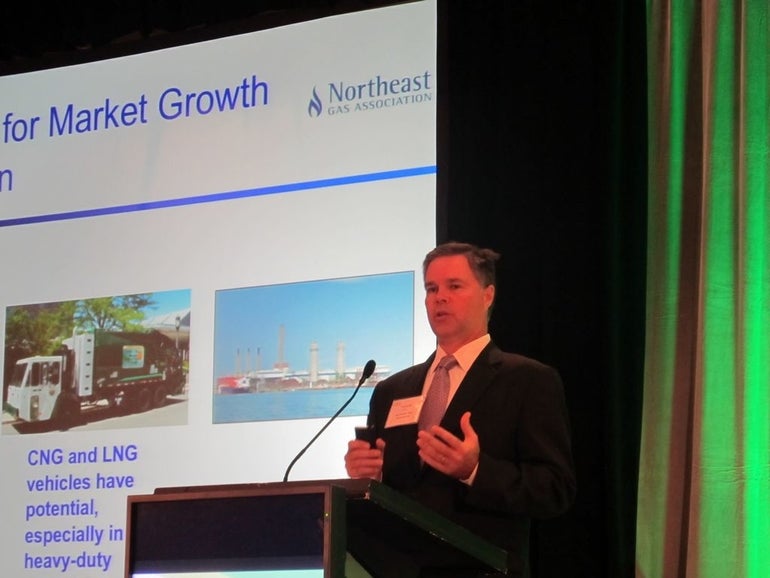The natural gas industry is gunning to be the top fossil fuel provider, and it’s getting very close in New England, a top industry representative in the region said today.
Thomas Kiley, president and CEO of the Northeast Gas Association, said a natural gas boom has resulted over the past six years from the hydraulic fracturing, or “fracking,” of natural gas trapped in domestic shale rock.
And that’s affecting what businesses and homeowners use to heat their properties.
The difference in cost between heating with oil versus gas has widened in recent years, Kiley said at the Worcester Business Journal’s Mass. Energy Summit, held at the DCU Center in Worcester this morning.
“As a result, many people want natural gas,” he said.
That has meant spikes in conversion rates for utility companies, he noted. NStar is converting customer to natural gas heat at roughly five times its historic frequency, while National Grid has seen a 39-percent increase in 2012, and a 46-percent jump among commercial customers.
As it stands now, 47 percent of Massachusetts homes are heated by natural gas, Kiley said. He said the federal Energy Information Administration expects natural gas prices to remain relatively stable over the next 20 years, so that number will likely continue to grow.
Of course, things could change. When asked by a member of the audience about producers being able to make enough profit at current prices of roughly $3.50 per thousand cubic feet, Kiley admitted it’s difficult, but he said the industry expects the math to work out fine at $4 or $4.50 in the future.
He said producers are pushing the government to allow them to export more fuel, which could drive up the price.
While the United States is in the middle of a natural gas boom, challenges remain.
Kiley said there are far fewer natural gas vehicles in the United States than there are in Iran or other countries, which is largely due to the high cost of gasoline abroad and the fact that costly liquefaction facilities would be needed to build up the right infrastructure to support natural gas vehicles and ensure demand is there.
“They’re not going to throw two or $3 billion into infrastructure without some thought that someone is going to use that product,” he said.
He added that the industry wants to bring more pipelines into New England in the coming years as natural gas demand grows.
Kiley took several questions from the audience about the environmental impacts of fracking.
He acknowledged concerns over the water that’s used to blast trapped gas out of the rock, but said the industry believes best practices can help ensure it doesn’t pollute groundwater.
“We feel it can be done safely through best practices of the industry,” he said.
Nonetheless, various university and government studies have found evidence of methane and other chemicals in drinking water wells situated near gas wells and environmental groups.
Regulators are struggling to keep up, according to a recent report from the Government Accountability Office, who said the Environmental Protection Agency has trouble inspecting gas wells and testing impacts on drinking water because of a lack of baseline quality data, the dispersed nature of the natural gas industry and the rapid pace of its development.
National Grid Talk Solar Connection Backlog
In September, the Hanover Theatre began receiving 80 percent of its electricity from a solar farm in Leicester, but it might have been sooner, if National Grid had been quicker to connect the system to the electric grid, its facilities manager said today.
“That’s savings we were missing and it’s important to investors who missed key dates,” Hudson said.
Timothy Roughan, National Grid’s director of distributed resources, said state and federal incentives have caused a boom in solar projects across the state, leading to a backlog that’s challenging to manage.
“We went from just a few projects in 2008 and 2009 to many,” Roughan said. “We’re working diligently to free up those bottlenecks.”
But he said utility companies must also keep the power running for customers, and that the Superstorm Sandy didn’t help.
“The storm loses us three weeks of work,” he said.

